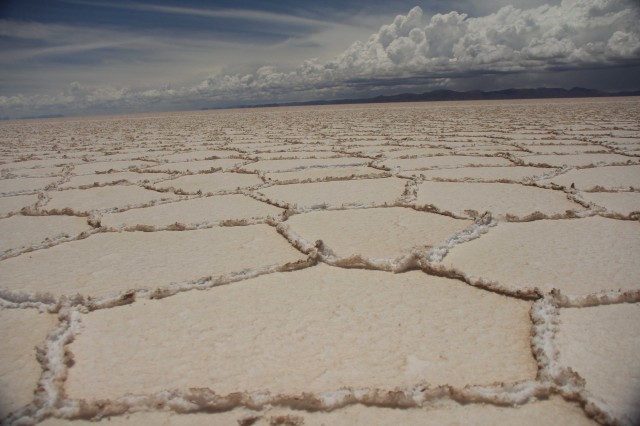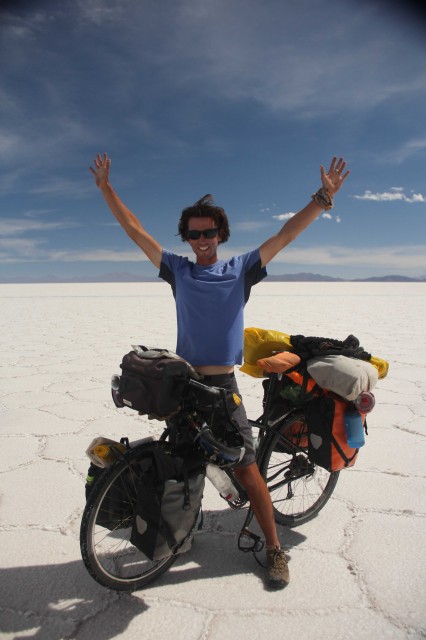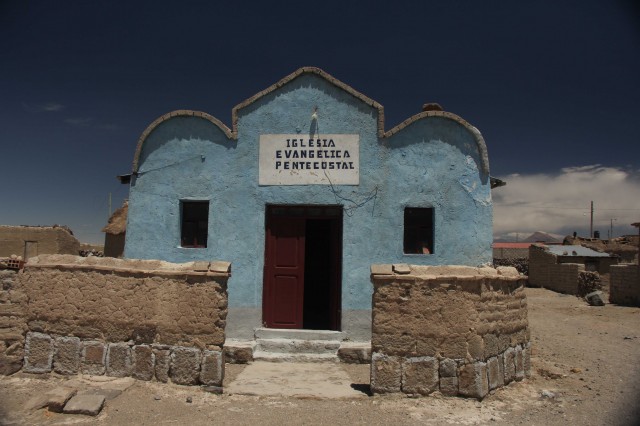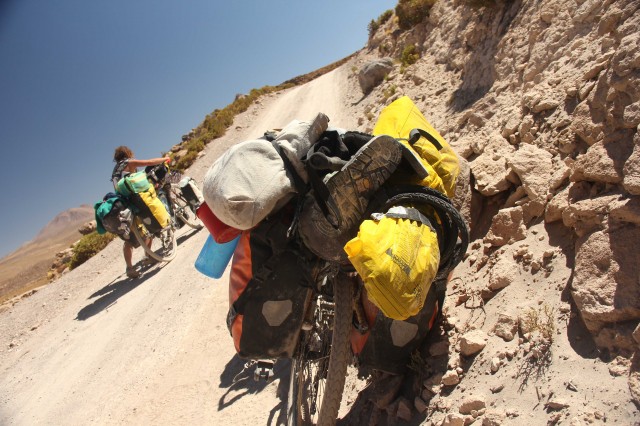The Salar de Uyuni is a surreal, awe-inspiring place. As the largest salt plain on earth, it is has the potential to leave you dizzy, pushing your senses into overdrive. As a sort of ‘Rite of passage’ for many cyclists in South America, we had dreamt of this strange place long before we landed down on the continent. We planned to cross the Salar De Uyuni, to its far western edge, where we would take a small road/track, onto the more remote and equally stunning Salar de Coipasa, which lies to the northwest.
We had just left The Silver city of Potosi, winding our way through canyons, alongside rivers, past small villages, enjoying and enduring many a hill climb. Our arrival in Uyuni revealed a hub of mass tourism catering for backpackers keen to explore the Salars by jeep. A string of Italian pizza restaurants lined the central plaza, alongside shops selling dubiously priced toilet paper, hand sanitizer and whiskey. We were ecstatic to be departing the following day, not in a jeep but on bicycles.
Navigation:
The Salar presented us with joyous cycling and the incredible feeling of being surrounded by a sea of crystal white salt, though this was not without a few small navigational issues on our first day! An inaccurate map from which we took a campus bearing, led us too far north of the island of Incahuasi, resulting in a 120km day, instead of a relatively leisurely 90km. The upside of our mistake, as we corrected our route, was trading our rattling side wind in for a tail wind. Turning drastically with darkness approaching and sunset blazing we screamed our way toward the shores of Isla de Incahuasi at 30kms an hour. Travelling without a GPS has only ever made for minor issues such as this, and it’s still by far our preferred method of navigation, or in this case non-navigation!
A storm and the meeting of cyclists:
The second day of Salar cycling presented us with issues of another sort: weather. Only after a rather leisurely start, did we begin to notice small clouds forming on the horizon. Initially we observed them with a certain ambivalence, though by mid afternoon, with blackened sky ahead, the first lightening struck. A dramatic storm ensued, pounding our intended path of travel. The best course of action was to set up camp beside a nearby island, sit the storm out and spend another night on the Salar. We pitched the tent quickly, battling against rising winds. Crawling inside was like arriving home to a warm fire! This tent really had become our safe haven over the previous months, more than just a cozy place to lay our heads to rest; it was the one constant in the midst of an ever-changing world outside.
An hour later, through the mist, I peered out of the tent to see three cyclists approaching us. They were soaked in rain, exhausted and ready to rest, confirming for us we’d made a good decision. That evening we shared hot chocolate and stories. The three cyclists of French and Swiss origin were heading south. They had just cycled through the rugged route we were hoping to follow north, criss-crossing the border between Bolivia and Chile. They spoke of the active volcanoes, and empty dirt roads, isolated hot pools and giant vistas. Though they told us that with heavy bikes this route would be unpleasant, near impossible, and suggested that we don’t consider too much.
So, now is the time to confess (as frowned upon as it may be in cycle touring circles) that we are not exactly the lightweight ‘Purists’ of cycle touring. In addition to the usual touring equipment such as tent, stove and sleeping bags, we were carrying between us: a drum, ukulele, lap top, umbrella, small black board, two small team mascots (a kiwi and a sheep), a tripod, and some Spanish language books. Most of this, for the purpose of writing and performing music throughout South America, and making small films about our journey. Some of it, just because it added to the fun!
The following day, we headed for Llica on the the far-flung, wind swept, western side of The Salar De Uyuni. Llica is a rough and tumble town of adobe brick houses and unpaved streets, with a surprising number of little shops stocked to the brim with fresh produce, its ferreterias (general stores) jam packed with hammers, tap handles, electrical sockets, bolts, screws and rubber ‘thing-a-me-bobs’, perfect for strapping wobbling water bottles to bikes, to stay put on rough roads!
It was here that we met a wonderful Swiss family, who’d custom built their own bicycles, complete with solar powered ‘pods’ connected behind, to carry their two children. With much enthusiasm, they handed us a ruffled piece of paper, upon it was hand-sketched map, of our dreamt about route to the north. Having cycled through the area with children in tow, they were completely convinced we would be more than capable, come hail, hellish roads and even heavy bikes! We were filled with excitement and inspiration! The information was still sketchy, the map outdated, the writing on it; barely readable, but we were ready to let go and explore this area which had intrigued us for so long.
A whole lot of sand:
While much of our journey through South America has involved challenging riding and pushing the bikes up steep hills, an unprecedented challenge lay ahead, on the flat road just north of Llica, between the Salar de Uyuni and Salar de Coipasa. Here we spent a long day slogging through 30kms of very deep sand, under a sweltering sun. Progress was painfully slow, balance was lost numerous times to the point that I felt like an infant learning to walk, shins were scraped against pedals and chain rings and harsh words were shouted! But somehow, there was a certain enjoyment in such self-inflicted pain! Still, we were eager to enter the Salar de Coipasa, and bid the sand farewell, so upon seeing the first sight of salt, we followed its allure before the road led us there. This was a grave mistake!
After the first kilometer of decent enough salt riding, the surface deteriorated, becoming soft, thick and wet. Salt, clung to our tyres, and covered our bicycles, panniers, shoes, legs, and clothing. We began to push the bikes again, hoping that the salt would re-solidify! Eventually it did… but only after a further 10kms of pushing, and not until the next day! Exhausted, we had set up camp near a small island and watched as the deep red blob of sun melted behind the mountains in the distant. With not a sound to be heard, and not another person for miles, we gazed in awe at our surroundings and were left wanting nothing…except perhaps a cold beer!
The following day offered the most gloriously smooth, solid, salt riding, across the Salar De Coipasa. We headed to the town of…..on ……island which lies in the centre of the plains. Here we stoked up on dry noodles, crackers, canned tuna, and even a small bottle of whiskey for those long wilderness nights. We met the friendly locals, marveled at their village on an island surrounded by a sea of salt, then we pushed on toward the far western side of the Salar de Coipasa.
The border of Chile lay waiting for us the following day, and beyond that, our much anticipated route through the volcanoes of the high Altiplano.
















